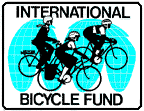Cuba's Bicycle Policy

![]() IBF is 100%
IBF is 100%
solar powered
![]()
Cuba Maintains Bike Priority
By David Mozer
Cuba made headlines in the early 90’s by implementing an aggressive bike transport policy. Between 1991 and 1997 they increased their bike supply by over 2 million: 1.5 million were imported, primarily from China, and another half million were produced domestically. But this was a shotgun marriage. The collapse of the Soviet Union had shut-off their source of cheap oil and Cuba could afford to do little else. Cuba has not historically had a bicycle culture. In fact, at one point Havana had more cars per capita than any other city in the western hemisphere and later officials tried to ban bikes in one city. So the question is, "Is Cuba’s bike binge permanent or ephemeral?"
Seven years later the official answer is that "bikes are still a priority", but the full answer may be more complex than that. In the interim new supplies of petroleum have been secured, the old cars are back on the roads, new fleets of cars and buses are being imported, the economy has moved out of it’s dive and is starting to flourish and some of the old motoring habits have been revived.
There are also direct deterrents to cycling: lack of bikes, tools and spares, road safety, food shortages, mechanical problems with bikes, lack of bike infrastructure, poor pavement conditions, a shortage of metal and paint for traffic signs, raised traffic markers * are broken, missing, or need painting, and diesel pollution from trucks and buses is a health hazard.
[* Cuban engineers feel that the raised traffic markers ("traffic turtles"), which are frowned upon most places have been very successful in helping them to reduce accidents.]
In this setting, the Communist Party Congress "Economic Resolution" of December 1997, called for "massive use of bikes as personal transport for reasonable distant trips…for the foreseeable future." The economic plan includes 28 elements which include bicycles. Domestic bicycle production continues at 100,000 per year and most of the problems sited above are addressed to some degree. Clearly some Cuban officials still see bikes as having an economic and environmental advantage.
Even before this, in 1996, an inter-governmental Bike Resource Committee was formed. Their efforts are, in part, reflected in the 1997 economic resolution.
The 1998 work plan commits resources to: getting more bikes to cities throughout the country, increasing the supply of tubes and other spares, reducing the cost of bike repair, increasing bike parking and a nation wide traffic safety education campaign though radio, TV and newspapers. The campaign stresses the responsibilities of everyone: cyclists, pedestrians and motorists.
Another aid to cycling is the government’s plan to adopt technical standards for vehicle emissions and air pollution. They are not to expect them to be as stringent as those in Europe and North America, because Cuba’s motor vehicle fleet is much older. They were described as regulations that will start the process of cleaning up the exhaust and that should be strengthened in the future. Vehicles not meeting the standards will be impounded.
There will also be some modifications in the old program: Initially the distribution of bikes was aimed at people living 10km from their work place. This generated complaints about heat, rain and arriving too exhausted. The target population has been changed to make the top priority those with 5km commutes. The program still targets more highly educated and trained people like university graduates and technical people. Probably for good reason – this is the segment of the population that is seen as the most likely to become motorized. In fact a young professional that I met, with a commute of only a few miles, has parked his bike for the last few months now that he has a motorcycle. Another man I met had just traded-up his motorcycle for a car. The legacy of the motor-culture remains. It is still a race to install and instill a bike-culture so that as their economic choices increase the people choose sustainable transport.
Even without these new efforts, Havana is a gem of a city with a lot of pedestrian only streets and where if you are going to catch a taxi it is likely to be pedal-powered variety.
Links of Interest:
Home | About Us | Contact Us | Contributions | Economics | Education | Encouragement | Engineering | Environment | Bibliography | Essay Contest | Ibike Tours | Library | Links | Site Map | Search
![]()
The International Bicycle Fund is an independent, non-profit organization. Its primary purpose is to promote bicycle transportation. Most IBF projects and activities fall into one of four categories: planning and engineering, safety education, economic development assistance and promoting international understanding. IBF's objective is to create a sustainable, people-friendly environment by creating opportunities of the highest practicable quality for bicycle transportation. IBF is funded by private donation. Contributions are always welcome and are U.S. tax-deductible to the extent allowed by law.
![]()
![]() Please write if you have questions, comment, criticism, praise or
additional information for us, to report bad links, or if you would like to be
added to IBF's mailing list. (Also let us know how you found this site.)
Please write if you have questions, comment, criticism, praise or
additional information for us, to report bad links, or if you would like to be
added to IBF's mailing list. (Also let us know how you found this site.)
